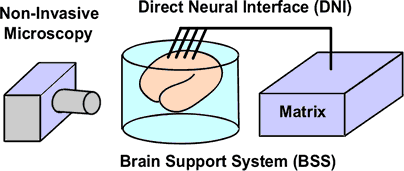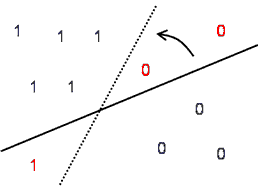< Previous
| Home
| Up
| Table of Contents
| Next >
Soft Uploading:
Outline of Soft Uploading v2.2
Soft uploading is a non-destructive variant of "standard" uploading
and somewhat akin to the "Moravec" procedure (cf Joe
Strout's web site). Claim: 1) Soft uploading is by most common-sensical
standards a true implementation of physical immortality;
and 2) It's probably the easiest approach (among other non-destructive methods)
to implement.
Note: Many details need to be worked out. The outline will
be subject to a lot of revisions that depend on, among other
things, what kind of technologies will be available in the future,
and the sequence of events.
The 2.0 version is much more realistic in terms of the design
of DNI and the neuromatrix. I think these two can pass
as 'technically feasible'. BSS remain relatively unexplored.
4-Part System
 The Isolated
Brain Support System (BSS) provides nutrients and
oxygen to the brain via perfusion with artificial blood.
The set-up may also include the spinal cord, a synthetic
body, or an avatar (ie a remote body separate from the biological
/ uploaded brain).
The Isolated
Brain Support System (BSS) provides nutrients and
oxygen to the brain via perfusion with artificial blood.
The set-up may also include the spinal cord, a synthetic
body, or an avatar (ie a remote body separate from the biological
/ uploaded brain).
The Direct Neural Interface (DNI) needs to
penetrate the neuropil and contact cell bodies of neurons, allowing
recording of membrane voltages as well as chemical information such
as neuronal cell types or types of neurotransmitters. The DNI
should also interact with the brain by sending signals to it
(bidirectional transmission).
Non-invasive 3-D microscopy is used to locate
neurons in the brain so that the DNI can establish connections
with a high percentage of them. Alternatively, connectivity
information can be extracted by molecular nanotechnology (outlined
in the DNI page).
The Neuromatrix is just a name for a high-performance
computer. Its main purpose (for now) is to gradually absorb
information from the brain. Over an extended period of time,
the brain deteriorates due to inevitable, biological ageing.
The "center of consciousness" gradually shifts from the brain
to the neuromatrix. Once the transfer of information is complete
(meaning a significant amount of information in the brain has
been transferred) then the "person" will live on the new substrate.
Explanation
1) BSS: The idea of an isolated brain support
system is not new. Currently there are a few medical companies
working on the problem of short-term brain perfusion (eg
for a few hours). Artificial blood is also an area of active
research and some of it has entered clinical use. The prolonged
sustaining of the brain would be more involved. One major
problem is hormones in the circulation: which hormones must
be provided by the blood substitute and which ones may be
omitted. There are ~200 known hormones. More details on BSS.
2) DNI: Each probe is an insulated microwire
(of ~0.1µm diameter) attached to a 'head-complex' that
makes use of a magnetic field to penetrate the neuropil (aided
by microscopy to locate neurons). When a target neuron is contacted,
an electrode will be inserted into the neuron.
The complex also injects into each neuron molecular tags that
allow the DNI to determine which neurons are contacted by that
neuron's axon(s).
For more details see the DNI page.
3) Non-invasive Microscopy: The resolution
of this microscopy need not be very high. 
 4)
Neuromatrix: This is the hardest part. Basically we're
faced with ~10-100 billion parallel channels of spike
train sequences from which neural information (synaptic
weights) has to be extracted. Massive parallel distributed
processing is required. The neuromatrix operates on the
idea of asymptotic convergence: synaptic weights are
extracted by an algorithm similar to the Perceptron learning
algorithm,
which has a low-order polynomial time complexity in n
= number of synapses. Mathematically each Perceptron
is a hyperplane dividing a hypercube whose coordinates
are synaptic weights. The learning algorithm progressively
adjusts this hyperplane according to the sign of the error
of the output. In fact, there exists a plethora of methods
(from adaptive modeling, statistical learning, etc) that can
be applied to this end (I have yet to sort this out, in the roadmap
of machine learning).
4)
Neuromatrix: This is the hardest part. Basically we're
faced with ~10-100 billion parallel channels of spike
train sequences from which neural information (synaptic
weights) has to be extracted. Massive parallel distributed
processing is required. The neuromatrix operates on the
idea of asymptotic convergence: synaptic weights are
extracted by an algorithm similar to the Perceptron learning
algorithm,
which has a low-order polynomial time complexity in n
= number of synapses. Mathematically each Perceptron
is a hyperplane dividing a hypercube whose coordinates
are synaptic weights. The learning algorithm progressively
adjusts this hyperplane according to the sign of the error
of the output. In fact, there exists a plethora of methods
(from adaptive modeling, statistical learning, etc) that can
be applied to this end (I have yet to sort this out, in the roadmap
of machine learning).
Another problem is to decide on the parametric model of biological
neurons. We may apply the statistical technique of dimensionality
reduction to arrive at a model with the minimum number
of independent parameters. Recent evidence in neurobiology suggests
that such a model is likely to be nonlinear (unlike the Perceptron).
Learning algorithms for nonlinear models usually takes the form
of gradient-descend.
Then, armed with connectivity information (extracted by the
DNI), the neuromatrix can be expected to extract a siginificant
fraction of the brain's content in one or a few decades (optimistic
guess), using the brain's own activity.
The above analysis rests on one assumption: Neurons communicate
with each other exclusively through spike trains, with the exception
of volume transmission (which includes gaseous diffusion). By Dale's
principle we may assume that one neuronal sub-type release
one blend of neurotransmitters / neurohormones. Thus the totality
of neuronal information can be captured by spike trains plus
the blend of neurochemicals of the cell-type in question.
For more details see the Neuromatrix page.
OUTSTANDING PROBLEMS
- Recently Dale's principle is found to be incorrect for some
mamallian CNS neurons
- Convergence may be too slow
- Metal wires may interfere with optical microscopy
< Previous
| Home
| Up
| Table of Contents
| Next >
Feb/2003, Aug/2003, Dec/2003, Feb/2004
Yan King Yin
 The Isolated
Brain Support System (BSS) provides nutrients and
oxygen to the brain via perfusion with artificial blood.
The set-up may also include the spinal cord, a synthetic
body, or an avatar (ie a remote body separate from the biological
/ uploaded brain).
The Isolated
Brain Support System (BSS) provides nutrients and
oxygen to the brain via perfusion with artificial blood.
The set-up may also include the spinal cord, a synthetic
body, or an avatar (ie a remote body separate from the biological
/ uploaded brain).
 4)
Neuromatrix: This is the hardest part. Basically we're
faced with ~10-100 billion parallel channels of spike
train sequences from which neural information (synaptic
weights) has to be extracted. Massive parallel distributed
processing is required. The neuromatrix operates on the
idea of asymptotic convergence: synaptic weights are
extracted by an algorithm similar to the Perceptron learning
algorithm,
which has a low-order polynomial time complexity in n
= number of synapses. Mathematically each Perceptron
is a hyperplane dividing a hypercube whose coordinates
are synaptic weights. The learning algorithm progressively
adjusts this hyperplane according to the sign of the error
of the output. In fact, there exists a plethora of methods
(from adaptive modeling, statistical learning, etc) that can
be applied to this end (I have yet to sort this out, in the
4)
Neuromatrix: This is the hardest part. Basically we're
faced with ~10-100 billion parallel channels of spike
train sequences from which neural information (synaptic
weights) has to be extracted. Massive parallel distributed
processing is required. The neuromatrix operates on the
idea of asymptotic convergence: synaptic weights are
extracted by an algorithm similar to the Perceptron learning
algorithm,
which has a low-order polynomial time complexity in n
= number of synapses. Mathematically each Perceptron
is a hyperplane dividing a hypercube whose coordinates
are synaptic weights. The learning algorithm progressively
adjusts this hyperplane according to the sign of the error
of the output. In fact, there exists a plethora of methods
(from adaptive modeling, statistical learning, etc) that can
be applied to this end (I have yet to sort this out, in the